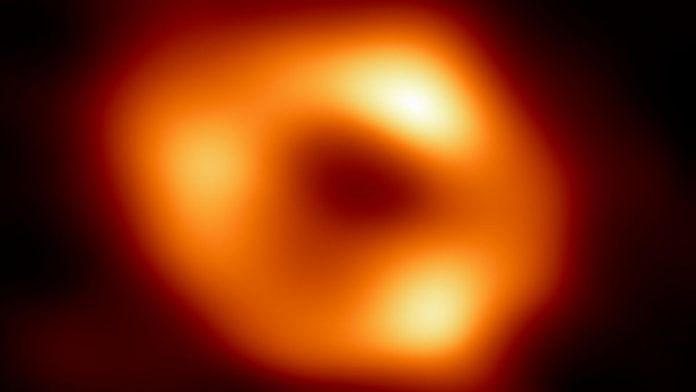New Delhi: Global research team Event Horizon Telescope (EHT) Collaboration has for the first time captured the image of the supermassive black hole of the Milky Way galaxy, using observations from a worldwide network of radio telescopes.
The image was shared via simultaneous press conferences around the world, including at the European Southern Observatory (ESO) headquarters in Germany. It provides overwhelming evidence that the object is indeed a black hole and yields valuable clues about the workings of such giants, which are thought to reside at the centre of most galaxies.
Scientists had previously seen stars orbiting around something invisible, compact, and very massive at the centre of the Milky Way. This strongly suggested that this object — known as Sagittarius A* (Sgr A*) — is a black hole.
The image released Thursday provides the first direct visual evidence of it.
The image is actually of glowing gas surrounding the blackhole, since the blackhole itself is completely dark.
The new view captures light bent by the powerful gravity of the black hole, which is four million times more massive than our Sun.
“We were stunned by how well the size of the ring agreed with predictions from Einstein’s Theory of General Relativity,” EHT Project Scientist Geoffrey Bower from the Institute of Astronomy and Astrophysics, Academia Sinica, Taipei said in a statement.
“These unprecedented observations have greatly improved our understanding of what happens at the very centre of our galaxy, and offer new insights on how these giant black holes interact with their surroundings,” Bower said.
The black hole is about 27,000 light-years away from Earth.
To image it, the team created the powerful EHT, which linked together eight existing radio observatories across the planet to form a single “Earth-sized” virtual telescope.
The EHT observed Sgr A* on multiple nights in 2017, collecting data for many hours in a row, similar to using a long exposure time on a camera.
This is not the first black hole to be imaged by ETH. In 2019, the collaboration had released the first image of the black hole M87*, at the centre of the more distant Messier 87 galaxy.
The Sgr A* is more than a thousand times smaller and less massive than M87*.
“We have two completely different types of galaxies and two very different black hole masses, but close to the edge of these black holes they look amazingly similar,” said Sera Markoff, Co-Chair of the EHT Science Council and a professor of theoretical astrophysics at the University of Amsterdam, Netherlands.
“This tells us that General Relativity governs these objects up close, and any differences we see further away must be due to differences in the material that surrounds the black holes,” Markoff said.
Also read: The science behind how teeth helped identify skeletons in Punjab as sepoys killed in 1857
Scientists worked for five years
According to scientists, this achievement was considerably more difficult than imaging M87*, even though Sgr A* is much closer to us.
EHT scientist Chi-kwan (‘CK’) Chan, from Steward Observatory and Department of Astronomy and the Data Science Institute of the University of Arizona, said: “The gas in the vicinity of the black holes moves at the same speed — nearly as fast as light — around both Sgr A* and M87*. But where gas takes days to weeks to orbit the larger M87*, in the much smaller Sgr A*, it completes an orbit in mere minutes.”
“This means the brightness and pattern of the gas around Sgr A* were changing rapidly as the EHT Collaboration was observing it — a bit like trying to take a clear picture of a puppy quickly chasing its tail,” Chan explained.
The researchers had to develop sophisticated new tools that accounted for the gas movement around Sgr A*.
While M87* was an easier, steadier target, with nearly all images looking the same, that was not the case for Sgr A*. The image of the Sgr A* black hole is an average of the different images the team extracted, finally revealing the giant lurking at the centre of our galaxy for the first time.
The effort was a partnership of more than 300 researchers from 80 institutes around the world that together make up the EHT Collaboration.
The team worked for five years, using supercomputers to combine and analyse their data, all the while compiling an unprecedented library of simulated black holes to compare with the observations.
Also read: Space is not silent. New NASA audioclip reveals what blackholes sound like



